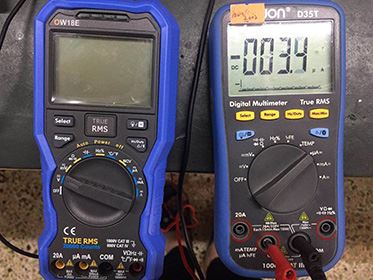Launched by Fujian Lilliput Optoelectronics Technology Co., Ltd, OW18E is a 4-1/2 bit multimeter. It continues the blue-tooth function of 41 series and supports synchronous Monitoring and offline recording of multiple multimeter. It can update the measurement data in real-time and automatically record to the mobile terminal, and display it in chart mode.


Compare with B41 series Bluetooth multimeter, OW18E has lower power consumption and longer standby time. The measured power consumption figure of OW18E as following:


From the figure, you can find, the power supply with 9V input at the OW18E, the current value of the measured input terminal is 0.31mA under the condition of normal start-up. Let's compare with Brand U's measured power consumption figure.


As shown in the figure, the measured current value at the input of the Brand U model *T56 is 1.94mA. According to the above two sets of figures, the power consumption of the new OW18E is one-sixth of that of Brand U, that is, under the same state, the use time of OW18E is six times of the Brand U.
Next, let's look at the power consumption of these two models after standby. The OW18E goes into standby mode after 30mins of without any operating.


From the above figure, we can find that after the standby of OW18E, the measured current value of the input terminal is only 3.3 uA. Next, let's compare with the power consumption of Brand U which after standby.
As shown in the diagram, the measured current value of brand U which after standby, the input terminal is 5.4 uA. Therefore, the standby power consumption of OW18E is also superior, which is almost twice that of Brand U.


Related Technical Article
- OW18E - Low Power Consumption, High Performance Multimeter
- Oscilloscope and Multimeter FAQ
- XDS Series High Vertical Resolution Oscilloscope (Part 3)
- XDS Series High Vertical Resolution Oscilloscope (Part 2)
- XDS Series High Vertical Resolution Oscilloscope (Part 1)
- Popular Features of Current Oscilloscopes
- Why is the measured amplitude less than the real value?
- Introduction of comparator Part I
- What does oscilloscope consist of?
- Differences between oscilloscope and multimeter
